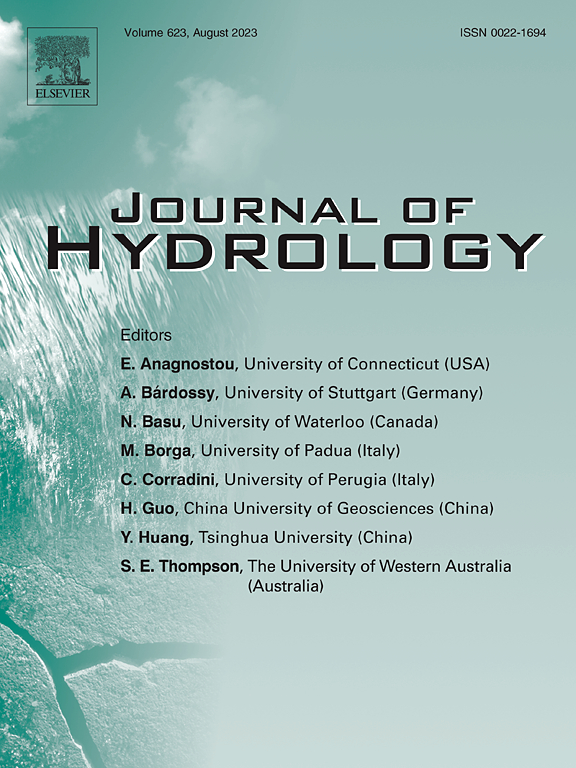Oyster culture and hydrological characteristics regulate the distribution and accumulation of sedimentary organic matter in two subtropical mariculture areas
IF 6.3
1区 地球科学
Q1 ENGINEERING, CIVIL
引用次数: 0
Abstract
Coastal oyster culture significantly regulates the content and composition of sedimentary organic matter (SOM), but its specific mechanism remains unclear. In this study, the dynamics and influencing factors of SOM in two subtropical oyster farming bays of Dapeng Cove (DPC, strong hydrodynamic force) and Zhanjiang Bay (ZJB, week hydrodynamic force), northern South China Sea, were compared and analyzed. Results showed comparable organic carbon (OC) levels between DPC (0.81 ± 0.48 %) and ZJB (0.81 ± 0.29 %) in sediments, while the content of total nitrogen (TN) in the DPC (0.073 ± 0.049 %) was notably lower than that in the ZJB (0.102 ± 0.050 %), reflecting regional variations in SOM composition. Source analysis revealed that marine primary production dominated SOM (64.50 ± 12.17 %) in the DPC, followed by oyster biodeposition (20.05 ± 6.99 %) and terrestrial input (15.45 ± 12.97 %). In contrast, the SOM in the ZJB mainly originated from terrestrial input (43.42 ± 16.20 %) and marine primary production (40.96 ± 6.94 %), with minimal oyster contribution (15.62 ± 10.39 %). Spatially, the SOM in the DPC and ZJB showed significant heterogeneity across horizontal/vertical gradients, driven by integrated physical-biogeochemical interactions. The SOM dynamics in the DPC were mainly governed by bottom-water oxygen, sediment grain-size composition and tidal action, while it in the ZJB was driven by terrestrial input, marine primary production and sediment grain-size composition. Oyster farming also enhanced SOM accumulation through biodeposition and hydrodynamic attenuation, particularly in mariculture areas of the ZJB due to low-energy environment.

牡蛎养殖和水文特征调节了两个亚热带海水养殖区沉积有机质的分布和积累
海岸带牡蛎养殖对沉积有机质(SOM)的含量和组成有显著调节作用,但其具体机制尚不清楚。本研究对南海北部大鹏湾(DPC,强水动力)和湛江湾(ZJB,弱水动力)两个亚热带牡蛎养殖湾的SOM动态及其影响因素进行了比较分析。结果显示类似的有机碳(OC)水平之间的DPC(0.81 ±0.48 %)和ZJB(0.81 ±0.29 %)在沉积物,而总氮(TN)的内容DPC(0.073 ±0.049 %)明显低于ZJB(0.102 ±0.050 %),反映区域SOM成分的变化。源分析显示,海洋初级生产主导SOM(64.50 ±12.17 %)DPC,紧随其后的是牡蛎biodeposition(20.05 ±6.99 %)和陆地输入(15.45 ±12.97 %)。相比之下,SOM在ZJB主要源于陆地输入(43.42 ±16.20 %)和海洋初级生产(40.96 ±6.94 %),以最小的牡蛎的贡献(15.62 ±10.39 %)。在空间上,DPC和ZJB的SOM在水平/垂直梯度上表现出显著的异质性,受物理-生物地球化学综合相互作用的驱动。DPC的SOM动态主要受底水氧、沉积物粒度组成和潮汐作用的控制,而ZJB的SOM动态主要受陆地输入、海洋初级生产和沉积物粒度组成的驱动。牡蛎养殖也通过生物沉积和水动力衰减促进了SOM的积累,特别是在ZJB的海水养殖区,由于低能量环境。
本文章由计算机程序翻译,如有差异,请以英文原文为准。
求助全文
约1分钟内获得全文
求助全文
来源期刊

Journal of Hydrology
地学-地球科学综合
CiteScore
11.00
自引率
12.50%
发文量
1309
审稿时长
7.5 months
期刊介绍:
The Journal of Hydrology publishes original research papers and comprehensive reviews in all the subfields of the hydrological sciences including water based management and policy issues that impact on economics and society. These comprise, but are not limited to the physical, chemical, biogeochemical, stochastic and systems aspects of surface and groundwater hydrology, hydrometeorology and hydrogeology. Relevant topics incorporating the insights and methodologies of disciplines such as climatology, water resource systems, hydraulics, agrohydrology, geomorphology, soil science, instrumentation and remote sensing, civil and environmental engineering are included. Social science perspectives on hydrological problems such as resource and ecological economics, environmental sociology, psychology and behavioural science, management and policy analysis are also invited. Multi-and interdisciplinary analyses of hydrological problems are within scope. The science published in the Journal of Hydrology is relevant to catchment scales rather than exclusively to a local scale or site.
 求助内容:
求助内容: 应助结果提醒方式:
应助结果提醒方式:


